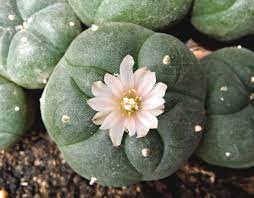 Mescaline or mescalin is a naturally occurring psychedelic protoalkaloid.
Mescaline or mescalin is a naturally occurring psychedelic protoalkaloid.
It is of the substituted phenethylamine class, known for its hallucinogenic effects comparable to those of LSD and psilocybin.
It occurs naturally in several species of cacti.
The usual human dosage is 200–400 milligrams of mescaline sulfate or 178–356 milligrams of mescaline hydrochloride.
The average 76 mm (3.0 in) peyote button contains about 25 mg mescaline.
Mescaline has suggested medical usage, including treatment of alcoholism and depression.
It is a Schedule I controlled substance.
Mescaline is biosynthesized from tyrosine which, in turn, is derived from phenylalanine by the enzyme phenylalanine hydroxylase.
Tyrosine and phenylalanine serve as metabolic precursors towards the synthesis of mescaline.
Tolerance to mescaline builds with repeated usage, lasting for a few days.
Mescaline causes cross-tolerance with other serotonergic psychedelics such as LSD and psilocybin.
About half the initial dosage is excreted after six hours, and between 20% and 50% of mescaline is excreted in the urine unchanged, with the rest being excreted as the deaminated-oxidised-carboxylic acid form of mescaline, a likely result of MAO degradation.
The LD50 of mescaline has been reported to be approximately 880 mg/kg.
It induces a psychedelic state comparable to those produced by LSD and psilocybin.
Its effects may include altered thinking processes, an altered sense of time and self-awareness, and closed- and open-eye visual phenomena, prominence of color appearing brilliant and intense, recurring visual patterns include stripes, checkerboards, angular spikes, multicolor dots, and very simple fractals that turn very complex.
LSD, and mescaline induces distortions of form and kaleidoscopic experiences but they manifest more clearly with eyes closed and under low lighting conditions.
As with LSD, synesthesia can occur.
A unique characteristic of mescaline use is the “geometrization” of three-dimensional objects.
Mescaline elicits sympathetic arousal, with the peripheral nervous system being a major target for this substance.
Mescaline acts similarly to other psychedelic agents, acting as an agonist, binding to and activating the serotonin 5-HT2A receptor with a high affinity.
Mescaline has even greater binding affinity for the serotonin 5-HT2C receptor.
